Campaign Tunisia: Clearing Jebel el Guessa

28 days after landing in North Africa, the American 1st Armored division, 1st, and 2nd Bns, 6th Infantry Regiment found themselves dug in at the Tebourba Gap listening to the approaching tank treads of the German 10th Panzer division. The following is an after-action report from this engagement:
At 8 AM, on Djebel el Guessa B and C company send patrols out ahead of their positions. Visibility is down to 5 kilometers. A company has already spotted a mixed force of German Fallschirmjagers and infantry are spotted west of El Bathan, but the worry is that they are trying to flank the battalion positions.
27th Armored Field Artillery battalion begins to shell them with their 105mm guns from six kilometers away as A company spots them on the flat.
By 10:00 AM a 7-kilometer wide frontal attack is developing along the ridge. Three German armored companies have joined them.
42 M3 Lees and M3A1 Stuarts of the 1st and 2nd battalions of the 13th armored regiment careen across the desert to hit the German left flank.
At 12:00 A company hops in their half-tracks and retreats 2 kilometers away from the approaching Germans towards the ridge crest (objective position) at Djebel el Guessa.
The 27th is called on by A troop 81st Armored Recon for fire support as an approaching German motorized company appears only three kilometers away.
Concerned about the attack, 1st Division HQ orders 2nd battalion down from their prepared positions on Djebel Lanserine, two kilometers closer to the Medjerda River. 1st battalion is getting pasted up on the ridge across the river and the 2nd is still two hours away from reinforcing them.
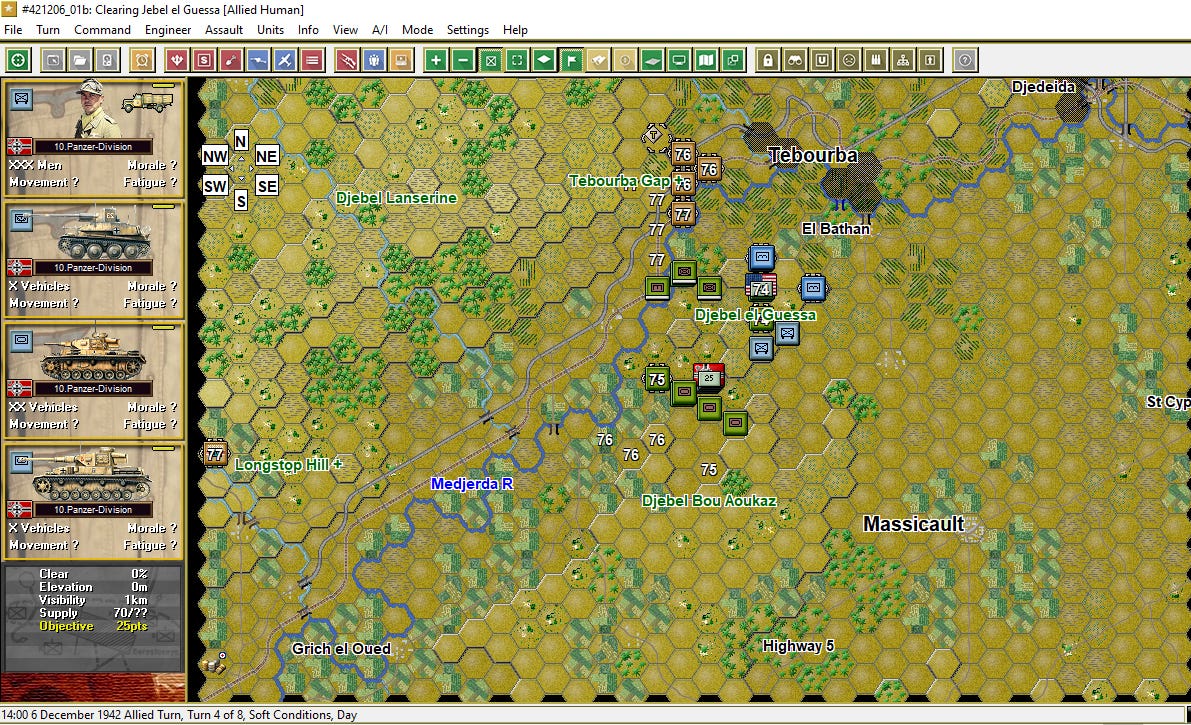
At 14:00, the 2nd battalion is across the Mjerda and hopping off their trucks, just as B company is pulled out of the line, a shell of itself. Fatigued GIs retreat past them through the olive orchards along the river, looking for a new position to dig in.
1st and 2nd tank battalions crash into a German Panzer battalion. At a range of 1km, the Stuarts knock out 2 Panzers.
16:00 hours, the tanks are still engaging each other at a range of 1km. 4 more Panzers are knocked out, but six Lees and Stuarts are burning on the ridge. They send up black plumes of smoke, which are clearly visible to the Highlanders of the 36th Inf bridge, defending the Gap some 8 km north of the battle.
A and B companies of the 1st are broken and demoralized, with A down to just 29 men. C meanwhile is stuck up on the ridge, nearly surrounded. There is a 1 km wide corridor to the river, but passing along it would be suicide, so they stay where they are in their foxholes and hope the 2nd battalion can pry open the vise.

18:00 hours, The tanks of the 13th Armored regiment push the German panzers off of the ridge with no further losses, as the 10th Panzer shifts, it’s forced to meet the American 2nd Battalion’s attack to reclaim 1st battalion’s positions.
The 27th field artillery battalion’s 105’s are running hot again as they shell the German half-tracks in the fields below the ridge to the east of them. The Germans have cut C company completely off, while A and B companies have crossed the river to relative safety. Isolated, C company has no supply and no morale. They are barely clinging to that ridge.
20:00 hours, it is night upon the Djebel el Guessa and C company is disintegrating under the pressure of being surrounded, as German soldiers round small groups of them up in the moonlight. The rest of 1st battalion heads towards the rear, shattered. The 2nd battalion commander has made the tough decision to pull back to the river. He can hear the small arms fire and cough of German tanks shelling C company’s shrinking position, but there is no way he can get up there without heavy losses. Thankfully, he says to his sergeant, “no one at division has the appetite for getting their ass kicked again.”
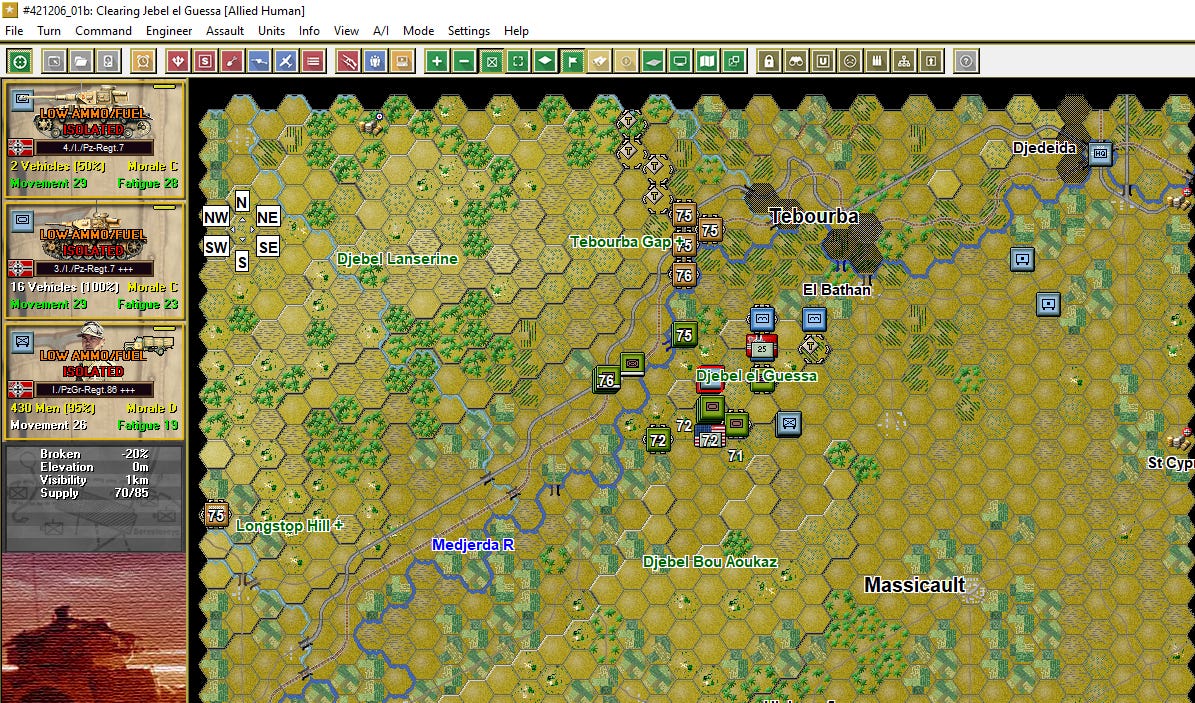
02:00 hours, in a last-minute change of heart, 1st and 2nd tank battalions are sent in as relief for C company as the Germans withdraw slightly from the ridge. Gunfire erupts as the battalions run into German tanks dug-in on the downslope beneath C company’s position.
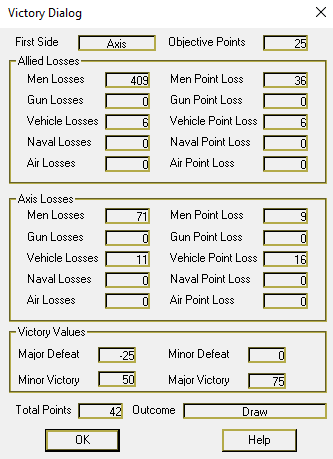
The aftermath
Losses are heavy for the 1st battalion. Yesterday, 1st battalion had 495 effectives. Today, there are only 184 men left, and that includes the 56 surrounded men of C company clinging to the ridge.
11 burned-out hulks of Panzers are smoldering in an around 1st Battalion’s positions. The smaller Stuarts and the heavier Lees closed quickly with the Panzers and flanked them. The results show just that.
But the losses within the 6th Infantry Regiment are horrific. 2nd Battalion’s attack across the Medjerda was ill-fated from the beginning. 1st Battalion was quickly overrun by 10th Panzer before American reinforcements could arrive. The scenario is scored as a draw, but it sure doesn’t feel like one.
Scenario particulars:
Title: #421206_01b: Clearing Jebel el Guessa [Allied Human]
Length: 8 turns
Unit Density (my grade): Light
Strength:
10th Panzer: 1614 Men, 9 guns, 29 vehicles
First Army: 1784 Men, 74 vehicles
Game: John Tiller Software, Panzer Campaigns, Tunisia 43
Author: Saunders and Blackie
AI rating (my grade): Solid
Description: S of Tebourba, Dec 6th, 1942: Both sides wanted to resume their offensives but it was the Germans who strick first. They moved part of 10PzD south of the Medjeda river in preparation for an attack along both sides of the river. First of all the Jebel el Guessa had to be cleared as it afforded perfect all-round observation of the area. The US 1st Bn. 6th Arm'd Inf., was strung out thinly along the Jebel, supported by the 27th Arm'd Field Arty Bn. It was here, from the north and southeast, that the Germans struck preceded by 2 waves of Stukas. Help was sent from the reorganizing CCB and by nightfall, all was quiet again, but the all-important high ground had been lost, as the infantry had been obliged to withdraw to protect their line of communication. [Size, small] Designer Note: This scenario has been optimized for Allied Human.
Rules Highlight:
Visibility is limited in this scenario. Toggling patrolling as an option increases visibility by a hex. I place B and C companies into this state to watch 1st Battalion’s positions on Turn 1. A company having already spotted the approaching Germans does not send out any patrols.
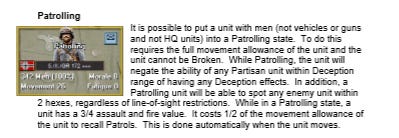
I am playing this game with the Local Supply Value for my Allied troops toggled. Seeing the supply value for each unit, is another way of seeing which units are capable of an attack, and which units are not. It is also a great reminder to keep units within command range.
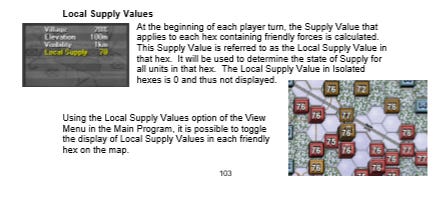


Comments
https://www.google.com/maps/dir/El+Batan,+Tunisia/Jebel+el+Guessa,+Tunisia/@36.4273859,9.2064844,188263m/data=!3m1!1e3!4m14!4m13!1m5!1m1!1s0x12fdce7cec777be9:0xd8016f9e0d4dc8c5!2m2!1d10.0010105!2d35.7119362!1m5!1m1!1s0x12fb4986ba8153f9:0xc169eaa92cec68c6!2m2!1d8.8741667!2d36.8752778!3e0
The AAR makes it sound like its far less than that.